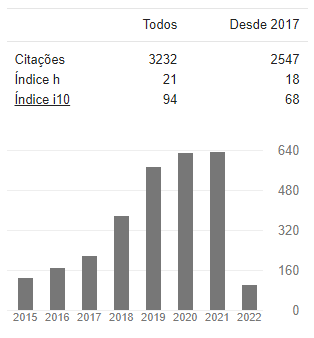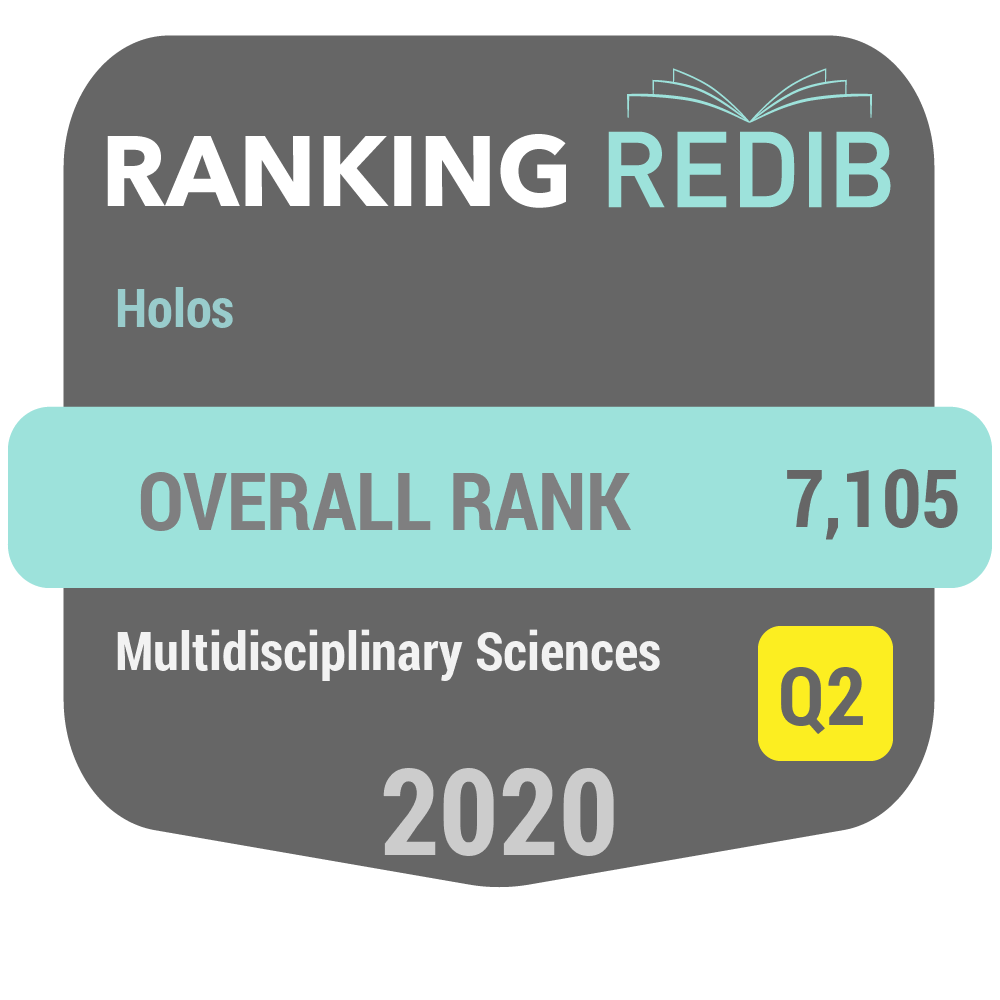Characterization of different samples of the gypsum mineral from the Araripe gypsum Pole: from macro to micro with Rietveld refinement
DOI:
https://doi.org/10.15628/holos.2023.14902Palavras-chave:
Mineral Gipsita, Difração de raios-X, Fluorescência de raios-X, Método Rietveld, Polo Gesseiro do AraripeResumo
O mineral gipsita é composto por sulfato de cálcio di-hidratado e tem como principal aplicação a produção de gesso. Nas jazidas do polo gesseiro do Araripe ocorrem, in natura, diferentes variedades, identificadas pelos nomes: "Johnson", alabastro, "estrelinha", "cocadinha", "rapadura" e "boró". A caracterização das variedades de gipsita em fratura foi realizada por MEV e a caracterização do pó foi realizada por FRX e DRX. Por FRX, a presença de CaO foi detectada com uma variação de 42,5% a 47,1% em massa, e SO3 com uma variação de 48,1% a 53,2% em massa. A partir da análise por DRX, foi identificada a fase maioritária de gipsita, com a presença dos planos cristalinos característicos do mineral. A partir do refinamento pelo método Rietveld obeteve-se um resultado X2 entre 0,86 e 1,11, e a partir deste, obter informações sobre a microestrutura das variedades de gipsita e sua célula unitária.
Downloads
Referências
Antunes, V. et al. (2014). Characterization of gypsum and anhydrite ground layers in 15th and 16th centuries Portuguese paintings by Raman Spectroscopy and other techniques. Journal of Raman Spectroscopy, v. 45, n. 11-12, p. 1026-1033. DOI: https://doi.org/10.1002/jrs.4488
Bouzit, S. et al. (2019). Characterization of natural gypsum materials and their composites for building applications. Applied Sciences, v. 9, n. 12, p. 2443. DOI: https://doi.org/10.3390/app9122443
Comodi, P. et al. (2008). High-pressure behavior of gypsum: A single-crystal X-ray study. American Mineralogist, v. 93, n. 10, p. 1530-1537. DOI: https://doi.org/10.2138/am.2008.2917
Eremin, A. et al. (2016). Determination of Calcium Sulfate Hemihydrate Modification by X-ray Diffraction Analysis. Procedia engineering, v. 165, p. 1343-1347, 2016. DOI: https://doi.org/10.1016/j.proeng.2016.11.862
Fukami, T. et al. (2015). Synthesis, Crystal Structure, and Thermal Properties of CaSO4.2H2O Single Crystals. International Journal of Chemistry, v. 7, n. 2, p. 12, 2015. DOI: https://doi.org/10.5539/ijc.v7n2p12
Gonçalves, N. S. et al, M. (2012). Size-strain study of NiO nanoparticles by X-ray powder diffraction line broadening. Matterials Letters, p. 36-38, v. 72. DOI: https://doi.org/10.1016/j.matlet.2011.12.046
Henry, P. F., Weller, M. T., & Wilson, C. C. (2009). Neutron powder diffraction in materials with incoherent scattering: an illustration of Rietveld refinement quality from nondeuterated gypsum. Journal of Applied Crystallography, v. 42, n. 6, p. 1176-1188. DOI: https://doi.org/10.1107/S0021889809043210
Klein, C., & Dutrow, B. (2012). Manual de ciências dos minerais. 23ed., Bookman. 716p.
Lins, C. A. C. (2018). Informe Geoquímico da Bacia do Araripe: estados de Pernambuco, Piauí e Ceará. CPRM.
Oliveira, F. M. et al. (2012). Características mineralógicas e cristalográficas da gipsita do Araripe. HOLOS, 5, p. 71–82. DOI: https://doi.org/10.15628/holos.2012.1140
Rietveld, H. M. (1969) A profile refinement method for nuclear and magnetic scructures. Acta Crystallographica. n. 2, p. 65-71. DOI: https://doi.org/10.1107/S0021889869006558
Schmid, T., Jungnickel, R., & Dariz, P. (2020). Insights into the CaSO4–H2O system: A Raman-spectroscopic study. Minerals, v. 10, n. 2, p. 115. DOI: https://doi.org/10.3390/min10020115
Sharpe R. & Cork G. (2006). Gypsum and anhydrite. In: Kogel JE, Kogel JE et al (eds) Industrial minerals & rocks. Society for Mining, Metallurgy, and Exploration, Inc, Littletown, p 519–540.
Silva, R.; Giulietti, M. (2010). Fosfogesso: geração, destino e desafios. Em: OLIVEIRA, J.; FERNANDEZ, F.; CASTILHOS, S. (eds). Agrominerais para o Brasil. Rio de Janeiro: CETEM; MCT, p 125-144.
Ungár, T. (2008). Dislocation Model of Strain Anisotropy. Powder Diffraction, v. 23, p. 125-132. DOI: https://doi.org/10.1154/1.2918549
Williamson, G. K., & Hall, W. H. (1953). X-ray line broadening from filed aluminium and wolfram. Acta metallurgica, v. 1, n. 1, p. 22-31. DOI: https://doi.org/10.1016/0001-6160(53)90006-6
Young, R. A. (1993). The rietveld method. International union of crystallography. Ed. Oxford University Press. v. 5, p. 1-38. DOI: https://doi.org/10.1093/oso/9780198555773.001.0001
Downloads
Publicado
Como Citar
Edição
Seção
Licença

Este trabalho está licenciado sob uma licença Creative Commons Attribution-NonCommercial-NoDerivatives 4.0 International License.









































